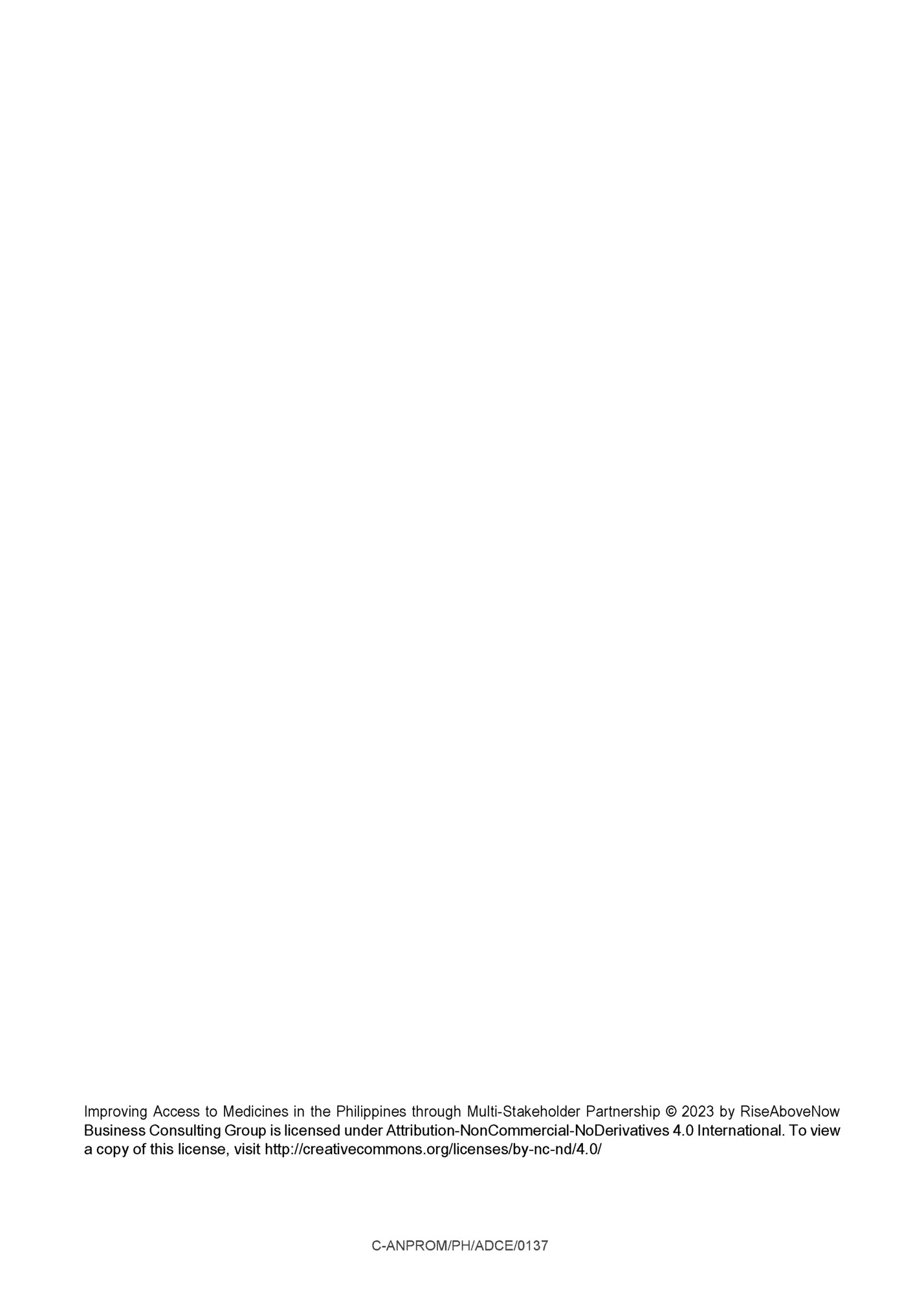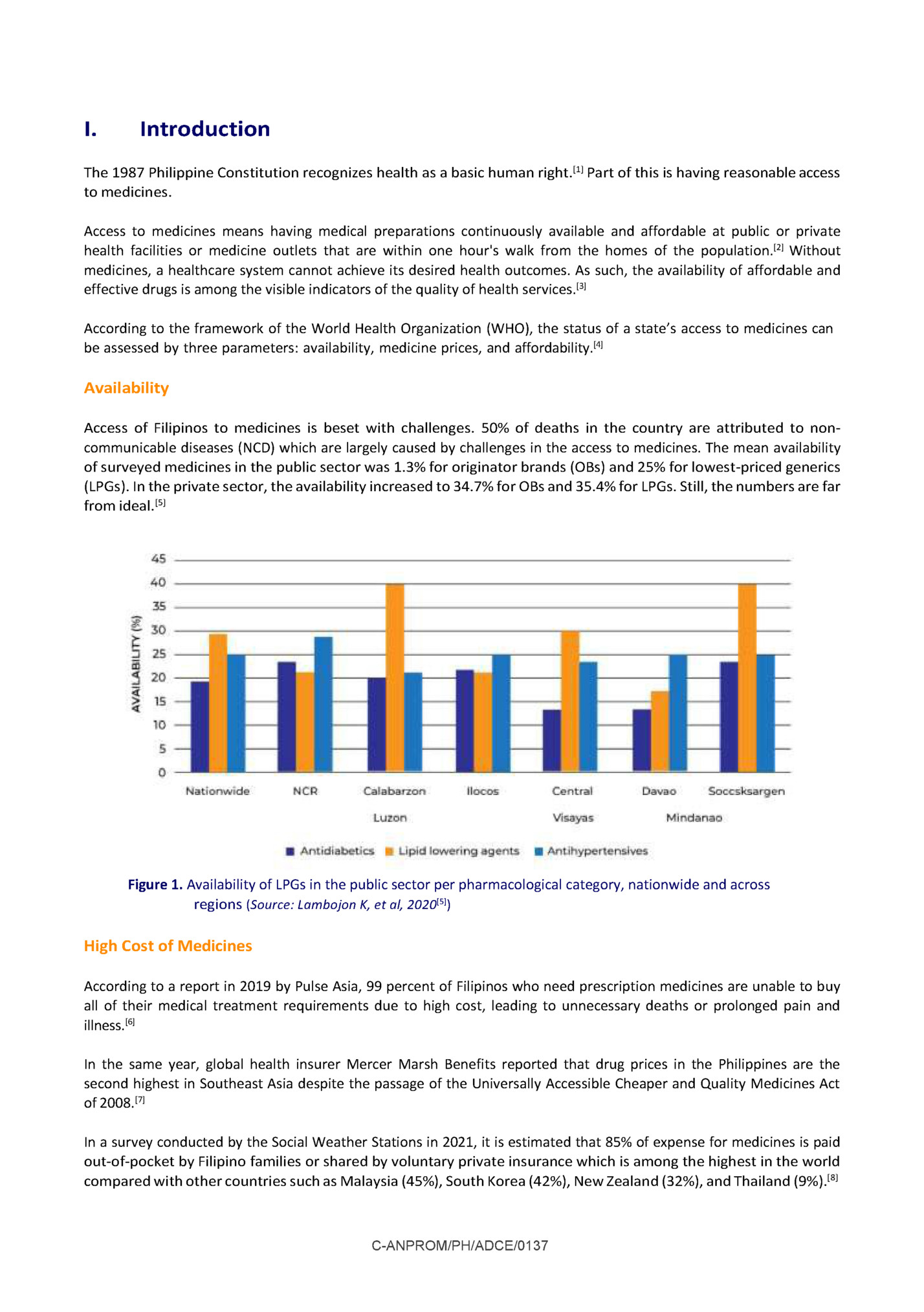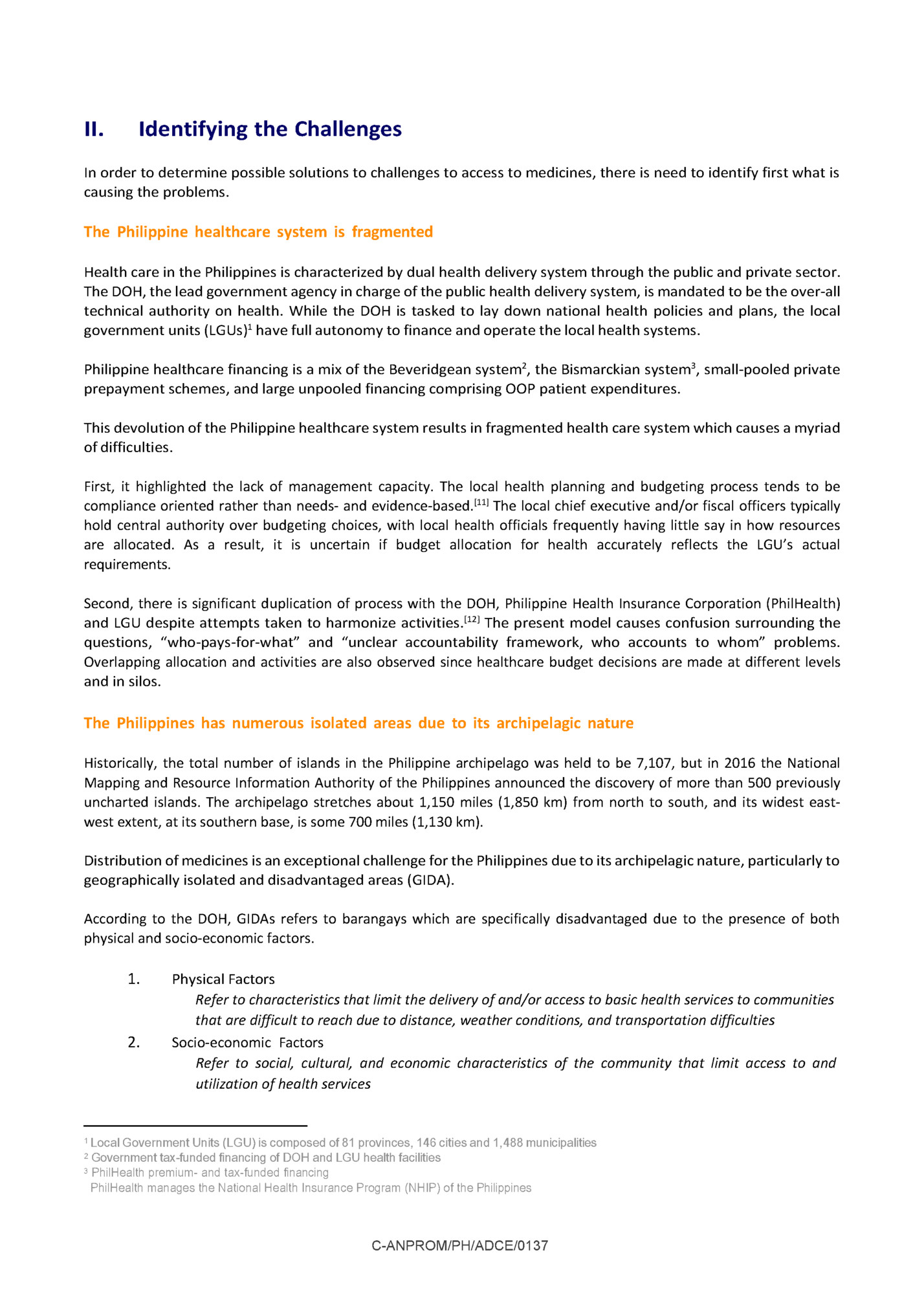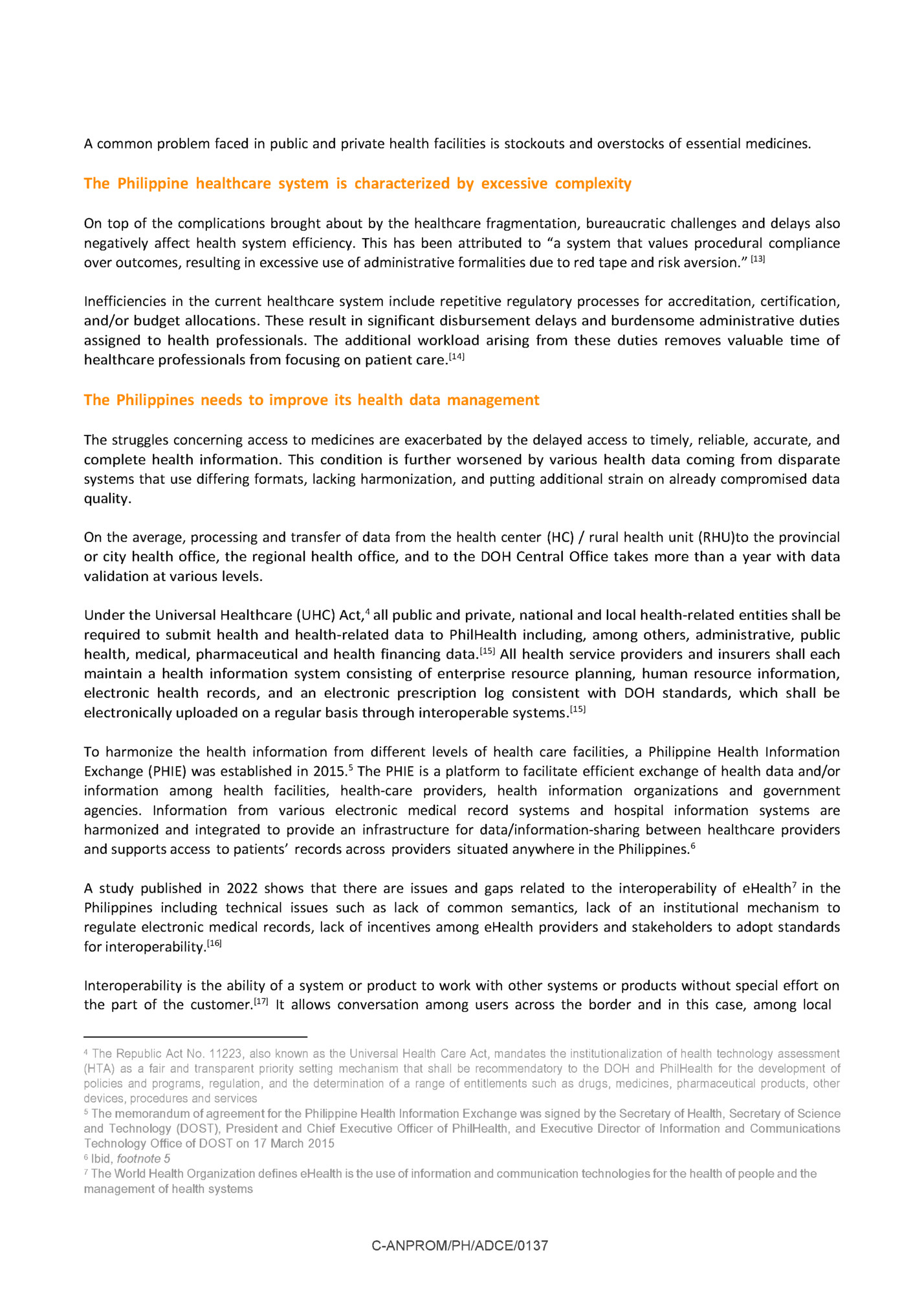Medicines in the Philippines through MuIti-Stakeholder Partnership Ranielle Mendoza, RPh, Principal, RiseAboveNow Business Consulting Group Bryan Posadas, RPh, MBA, Associate, RiseAboveNow Business Consulting Group Jeanne Pillejera, RPh, Associate, RiseAboveNow Business Consulting Group C-ANPROM/PH/ADCE/0137

Business Consulting Group is licensed under Attribution-NonCommercial-NoDerivatives 4.0 International. To view a copy of this license, visit http://creativecommons.org/licenses/by-nc-nd/4.0/ C-ANPROM/PH/ADCE/0137

BNB COVID-19 CSDH DPRI DOH DOST EML F1 Plus BNB GIDA HC HIV/AIDS HTA HTAC IA ICT IFC LGA LGU LPG MAP NCD NEDA NTP OB OOP PHIE PhilHealth PIDS PNF PPI PPIP PPP PPP Center RHU TB TF THD THE UHC UP WHO Botika ng Barangay Coronavirus 2019 Commission on Social Determinants of Health Drug Price Reference Index Department of Health Department of Science and Technology Essential Medicines List FOURmula One Plus Botika ng Bayan Geographically isolated and disadvantaged areas Health Center Human Immunodeficiency Virus / Acquired Immune Deficiency Syndrome Health Technology Assessment Health Technology Assessment Council Implementing Agencies Information and Communication Technology International Finance Corporation Local Government Academy Local Government Unit Lowest-priced Generics Managed Access Program Non-communicable Disease(s) National Economic and Development Authority National Tuberculosis Program; referring to Vietnam’s National TB Program Originator Brand Out-of-pocket Philippine Health Information Exchange Philippine Health Insurance Corporation Philippine Institute for Development Studies Philippine National Formulary Public–Private Interactions Public–Private Investment Partnership Public–Private Partnership Public–Private Partnership Center of the Philippines Rural Health Unit Tuberculosis Temasek Foundation Town Hall Discussion Total Health Expenditure Universal Health Coverage, also Universal Health Care University of the Philippines World Health Organization C-ANPROM/PH/ADCE/0137


Introduction The 1987 Philippine Constitution recognizes health as a basic human right.[1] Part of this is having reasonable access to medicines. Access to medicines means having medical preparations continuously available and affordable at public or private health facilities or medicine outlets that are within one hour's walk from the homes of the population.[2] Without medicines, a healthcare system cannot achieve its desired health outcomes. As such, the availability of affordable and effective drugs is among the visible indicators of the quality of health services.[3] According to the framework of the World Health Organization (WHO), the status of a state’s access to medicines can be assessed by three parameters: availability, medicine prices, and affordability.[4] Availability Access of Filipinos to medicines is beset with challenges. 50% of deaths in the country are attributed to noncommunicable diseases (NCD) which are largely caused by challenges in the access to medicines. The mean availability of surveyed medicines in the public sector was 1.3% for originator brands (OBs) and 25% for lowest-priced generics (LPGs). In the private sector, the availability increased to 34.7% for OBs and 35.4% for LPGs. Still, the numbers are far from ideal.[5] Figure 1. Availability of LPGs in the public sector per pharmacological category, nationwide and across regions (Source: Lambojon K, et al, 2020[5]) High Cost of Medicines According to a report in 2019 by Pulse Asia, 99 percent of Filipinos who need prescription medicines are unable to buy all of their medical treatment requirements due to high cost, leading to unnecessary deaths or prolonged pain and illness.[6] In the same year, global health insurer Mercer Marsh Benefits reported that drug prices in the Philippines are the second highest in Southeast Asia despite the passage of the Universally Accessible Cheaper and Quality Medicines Act of 2008.[7] In a survey conducted by the Social Weather Stations in 2021, it is estimated that 85% of expense for medicines is paid out-of-pocket by Filipino families or shared by voluntary private insurance which is among the highest in the world compared with other countries such as Malaysia (45%), South Korea (42%), New Zealand (32%), and Thailand (9%).[8] C-ANPROM/PH/ADCE/0137

A treatment regimen is considered affordable if it costs the equivalent of one day’s salary of the lowest-paid unskilled government worker; treatments that cost more than this are classed as unaffordable.[4] To address challenges of high prices of medicines, the government took various steps such as the promotion of generic drugs, the enactment of the Cheaper Medicines Act,[9] and the government-mediated access prices programs and the Department of Health (DOH) medicines access programs. Other measures taken were public sector importation of cheaper medicines and centralization of the procurement of medicines for public hospitals and clinics. Despite these measures, poor people still find it challenging to purchase the standard treatment of medicines.[10] A primary reason that creates challenges in medicine affordability would be the insufficient subsidy from the government. The SWS study above shows that there is high preference of Filipinos for free and subsidized medicines as the most helpful ways of obtaining medicines for a grave illness. While at the moment there is a form of government subsidy for medicines, it is only for certain diseases. There is clamor for the government support to expand to cover more health conditions especially for economically challenged patients.[8] Challenges in access to medicines is a massive undertaking that will benefit from multistakeholder collaboration. The COVID-19 pandemic has highlighted that government departments and public sector bodies are not often sufficiently equipped to resolve vast and intricate public health issues. In battling the pandemic, the private sector has shown that it can have major contributions to complement the efforts of the government to produce rapid, innovative solutions through effective partnerships. This paper therefore aims to understand the challenges around access to medicines and how partnerships can help resolve some, if not all, identified challenges. C-ANPROM/PH/ADCE/0137

Identifying the Challenges In order to determine possible solutions to challenges to access to medicines, there is need to identify first what is causing the problems. The Philippine healthcare system is fragmented Health care in the Philippines is characterized by dual health delivery system through the public and private sector. The DOH, the lead government agency in charge of the public health delivery system, is mandated to be the over-all technical authority on health. While the DOH is tasked to lay down national health policies and plans, the local government units (LGUs)1 have full autonomy to finance and operate the local health systems. Philippine healthcare financing is a mix of the Beveridgean system2, the Bismarckian system3, small-pooled private prepayment schemes, and large unpooled financing comprising OOP patient expenditures. This devolution of the Philippine healthcare system results in fragmented health care system which causes a myriad of difficulties. First, it highlighted the lack of management capacity. The local health planning and budgeting process tends to be compliance oriented rather than needs- and evidence-based.[11] The local chief executive and/or fiscal officers typically hold central authority over budgeting choices, with local health officials frequently having little say in how resources are allocated. As a result, it is uncertain if budget allocation for health accurately reflects the LGU’s actual requirements. Second, there is significant duplication of process with the DOH, Philippine Health Insurance Corporation (PhilHealth) and LGU despite attempts taken to harmonize activities.[12] The present model causes confusion surrounding the questions, “who-pays-for-what” and “unclear accountability framework, who accounts to whom” problems. Overlapping allocation and activities are also observed since healthcare budget decisions are made at different levels and in silos. The Philippines has numerous isolated areas due to its archipelagic nature Historically, the total number of islands in the Philippine archipelago was held to be 7,107, but in 2016 the National Mapping and Resource Information Authority of the Philippines announced the discovery of more than 500 previously uncharted islands. The archipelago stretches about 1,150 miles (1,850 km) from north to south, and its widest eastwest extent, at its southern base, is some 700 miles (1,130 km). Distribution of medicines is an exceptional challenge for the Philippines due to its archipelagic nature, particularly to geographically isolated and disadvantaged areas (GIDA). According to the DOH, GIDAs refers to barangays which are specifically disadvantaged due to the presence of both physical and socio-economic factors. 1. 2. Physical Factors Refer to characteristics that limit the delivery of and/or access to basic health services to communities that are difficult to reach due to distance, weather conditions, and transportation difficulties Socio-economic Factors Refer to social, cultural, and economic characteristics of the community that limit access to and utilization of health services Local Government Units (LGU) is composed of 81 provinces, 146 cities and 1,488 municipalities Government tax-funded financing of DOH and LGU health facilities 3 PhilHealth premium- and tax-funded financing PhilHealth manages the National Health Insurance Program (NHIP) of the Philippines 1 2 C-ANPROM/PH/ADCE/0137

The Philippine healthcare system is characterized by excessive complexity On top of the complications brought about by the healthcare fragmentation, bureaucratic challenges and delays also negatively affect health system efficiency. This has been attributed to “a system that values procedural compliance over outcomes, resulting in excessive use of administrative formalities due to red tape and risk aversion.” [13] Inefficiencies in the current healthcare system include repetitive regulatory processes for accreditation, certification, and/or budget allocations. These result in significant disbursement delays and burdensome administrative duties assigned to health professionals. The additional workload arising from these duties removes valuable time of healthcare professionals from focusing on patient care.[14] The Philippines needs to improve its health data management The struggles concerning access to medicines are exacerbated by the delayed access to timely, reliable, accurate, and complete health information. This condition is further worsened by various health data coming from disparate systems that use differing formats, lacking harmonization, and putting additional strain on already compromised data quality. On the average, processing and transfer of data from the health center (HC) / rural health unit (RHU)to the provincial or city health office, the regional health office, and to the DOH Central Office takes more than a year with data validation at various levels. Under the Universal Healthcare (UHC) Act,4 all public and private, national and local health-related entities shall be required to submit health and health-related data to PhilHealth including, among others, administrative, public health, medical, pharmaceutical and health financing data.[15] All health service providers and insurers shall each maintain a health information system consisting of enterprise resource planning, human resource information, electronic health records, and an electronic prescription log consistent with DOH standards, which shall be electronically uploaded on a regular basis through interoperable systems.[15] To harmonize the health information from different levels of health care facilities, a Philippine Health Information Exchange (PHIE) was established in 2015.5 The PHIE is a platform to facilitate efficient exchange of health data and/or information among health facilities, health-care providers, health information organizations and government agencies. Information from various electronic medical record systems and hospital information systems are harmonized and integrated to provide an infrastructure for data/information-sharing between healthcare providers and supports access to patients’ records across providers situated anywhere in the Philippines.6 A study published in 2022 shows that there are issues and gaps related to the interoperability of eHealth7 in the Philippines including technical issues such as lack of common semantics, lack of an institutional mechanism to regulate electronic medical records, lack of incentives among eHealth providers and stakeholders to adopt standards for interoperability.[16] Interoperability is the ability of a system or product to work with other systems or products without special effort on the part of the customer.[17] It allows conversation among users across the border and in this case, among local 4 The Republic Act No. 11223, also known as the Universal Health Care Act, mandates the institutionalization of health technology assessment (HTA) as a fair and transparent priority setting mechanism that shall be recommendatory to the DOH and PhilHealth for the development of policies and programs, regulation, and the determination of a range of entitlements such as drugs, medicines, pharmaceutical products, other devices, procedures and services 5 The memorandum of agreement for the Philippine Health Information Exchange was signed by the Secretary of Health, Secretary of Science and Technology (DOST), President and Chief Executive Officer of PhilHealth, and Executive Director of Information and Communications Technology Office of DOST on 17 March 2015 6 Ibid, footnote 5 7 The World Health Organization defines eHealth is the use of information and communication technologies for the health of people and the management of health systems C-ANPROM/PH/ADCE/0137

other health units or facilities in the context of privacy and ethics; and to promote and facilitate the long-term integration of technologies. The Department of Health gathers data on population health through the RHUs and HCs. This data is stored and managed by the Epidemiology Bureau, which can be provided to respective offices, as needed. The collection of these data, however, is limited to cases reported in government health facilities and does not include data from the private health facilities; this limitation hampers appropriate forecasts of the needs of the population. Cancer and rare diseases are deprioritized The Philippines has embarked on a major health reform under the UHC Act. One of the stipulations in the UHC Act is the creation of the Health Technology Assessment Council (HTAC). The HTAC is responsible for the review and recommendation of approval for inclusion in the Philippine National Formulary (PNF). The HTA process becomes a bottleneck for approval of innovative medicines needed by patients with rare medical conditions, as review prioritizes medicines used for conditions with higher prevalence. Patient groups expressed their concerns with accessing innovative medicines for cancer and rare diseases. One of the potential reasons identified is the lack of support provided by the national health system to the pharmaceutical companies in introducing new drugs in the country. The need for these medicines in the country must first be established before they may be allowed to enter the Philippine market. The low prevalence of these conditions among Filipinos do not make these medicines a priority for inclusion. Procurement Law and the Philippine Drug Price Reference Index (DPRI) are short-sighted In discussion paper published in 2021, the Philippine Institute for Development Studies (PIDS) urged the government to rethink price setting in the public procurement of drugs and medicines.[18] The DOH established the Philippine DPRI as the basis for the maximum government procurement price of pharmaceutical products. DPRI was designed to provide transparency in the pricing of essential medicines and to guide all national and local government health facilities in the procurement of essential medicines. The study of PIDS reveals the following insights [18]: 1. DPRI compliance is not associated with cheaper prices among successful procurements. 2. DPRI compliance is associated with longer posting periods of about 10 percent or roughly two days more than postings that are not DPRI-compliant. 3. DPRI also has a 17.7% probability of procurement failure, which leads to longer delays in the procurement process. 4. Difficulty in procuring medicines with few or sole providers because the approved budget for the contract is “too low in comparison to the market price.” 5. There often is a failure in bidding because of the low ceiling price in the DPRI. This is experienced throughout every region. Similar challenges arise due to the limitations in the current Procurement Law. The existing Procurement Law is deemed not suitable for many health sector transactions as it is too focused on the lowest bidder with little concern for quality. For instance, in 2000, the local government of Quezon City bought P1.8 million of pharmaceutical preparations which includes multivitamins and antibiotics which were found to be eventually failed quality tests conducted by the Food and Drug Administration as part of a special audit.[19] Skills in undertaking government procurement are also scarce, especially in LGUs. LGU-procured drug prices are often higher than those procured by the Central DOH.[20] Lack of procurement planning, including drug quantification, small purchases (diseconomies of scale) and emergency procurements are often cited as the reasons behind the higher prices.[19] C-ANPROM/PH/ADCE/0137

Fleepit Digital © 2021